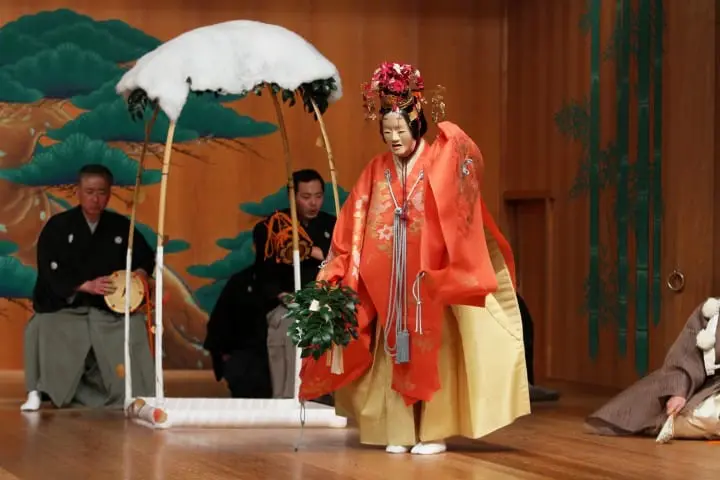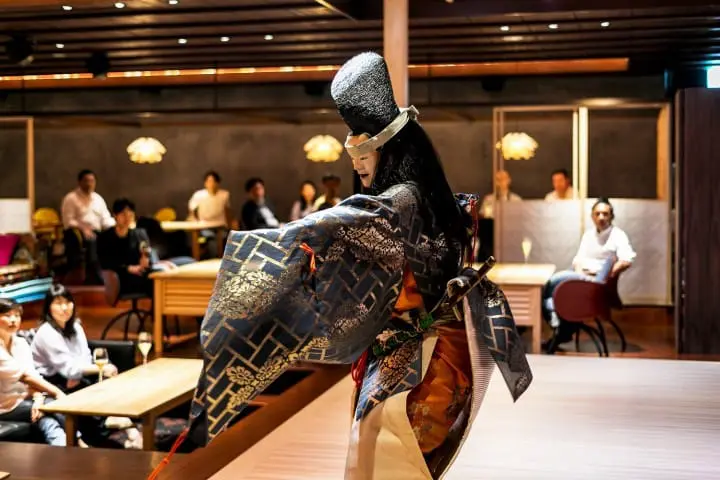Noh Theater: Stories About Staying Human in Times of War

Noh theater is one of Japan's classical performing arts, boasting a history of over six centuries and famous for being extremely refined and elegant. We introduce the features of this art and information on where to watch a Noh performance in Tokyo!
Noh Theater - A Stage Art with a 600-year History

Noh Sumidagawa ("Sumida River") © Yoshihiro Maejima
Noh theater boasts the longest tradition among Japan's classical performing arts, having reached an accomplished form around 650 years ago. Noh performances are being held regularly everywhere in Japan and the art has many fans nowadays.
In this article, we introduce some of the features that make Noh one of Japan's treasured traditions. Enjoy a Noh performance when visiting Japan!
Noh Theater Basics
1. The Features of Noh Theater
2. A Brief History of Noh Theater
3. Where to Watch a Noh Performance
1. The Features of Noh Theater

Noh "Lady Aoi" © Yoshihiro Maejima
Noh theater can be recognized by its specific Noh masks. Masks have been used in various traditional Japanese performing arts, most of them related to Shinto shrine rituals, where the performers impersonate deities and divine creatures. Kagura, the traditional shrine dances which can still be seen at festivals, are a predecessor of Noh.
Each role requires a different type of mask. The performer may need to play the role of a deity, of a woman, of a hero, of a demon or another fantastical creature.
Noh is itself a performing art centered on dance. The actor in the leading role (called shite) performs a formalized dance consisting of a sequence of movements that have been handed down through practice from master to disciple for generations.

Noh "Katsuragi" © Yoshihiro Maejima
The repertory of Noh theater consists at present of approximately 250 plays. There used to be many more in the Edo Period (1603 - 1968), but only the very popular ones have made into modern times.
Noh plays are usually based on legends and stories that were common knowledge at the time when this art was born, namely the Muromachi Period (1336 - 1573). At that time in Japanese history, the warrior class held the highest authority and Noh could develop because it received the support of the ruling class.
In other words, Noh theater reflects the ideals and dreams of the warrior class. Human values such as valiance, integrity, faithfulness, dignity or elegant beauty which were treasured by the warriors stand at the core of Noh.
Not by chance, the time when the most Noh plays were created coincides with the so-called “Warring States Period” (Sengoku jidai) which started in 1467 and lasted for about one century and a half.
It’s probably not an exaggeration to say that, during those times of constant military conflict, Noh and other highly aesthetic arts such as tea ceremony or ikebana (flower arrangement) were practiced as a way for the warriors to keep their humanity, in an attempt to compensate for the social and political chaos they were living in.
↑ Return to the top of article.
2. A Brief History of Noh Theater
1. The Beginnings of Noh as a Stage art

Noh Aoi no Ue ("Lady Aoi") © Yoshihiro Maejima
At the origin of Noh theater stand folk performances that were related to shrine and temple festivals in the 12th - 13th century Japan. In the 14th century, the large temples and shrines around Kyoto and Nara used to call professional actor troupes to perform at their festivals.
One of these troupes, Kanze, started to receive the support of the shogun of the time, Ashikaga Yoshimitsu (1358 - 1408), who enjoyed the art of its lead actors. This was the beginning of the patronage relationship between the warrior class and Noh actors, which was to last until the rule of the warrior class ended at the end of the Edo period (1603 - 1868).
It was toward the end of the 14th century when the leader of the Kanze school, Zeami (1363 - 1443), began his activity as an actor, playwright and theorist of Noh theater. Zeami created a great number of Noh plays (most of which still are in the Noh repertory at present). He also left several treatises on the art of Noh, written as guidebooks for his successors. Zeami's work was decisive for what Noh was to become in the following centuries.
2. Noh in the Edo Period (1603 - 1868)
After a century and a half of internal conflicts, the Edo Period (1603 - 1868) brought in a time of peace, after the Tokugawa shogunate united the country under its rule. For Noh, this was a time of flourishing. In addition to the professional Noh actors, amateur performers from the warrior class were also active. Hundreds of new Noh plays were created and it was during this time that the performance style was formalized and brought close to the form we can still see today.
3. Noh in Modern Times
At the beginning of the Meiji Period (1868 - 1912), the warrior class was abolished and Japan began to modernize. For Noh, this was a period of crisis, as it had lost its patrons. Although some professional actors were still active, a great part of the repertory and of the tradition was lost.
Noh had a revival only after WWII when Zeami's treatises were discovered. His theories on the art of Noh were found to be so consistent and inspiring that they brought a breath of fresh air in the practice of Noh. At present, Noh has many fans both in and outside of Japan, being practiced by thousands of professional actors and amateurs.
↑ Return to the top of article.
3. Where to Enjoy a Noh Performance

The Noh stage has specific structural features. The facilities housing such stages are called nohgakudo (Noh theaters). Every large city of Japan has several Noh theaters and even small towns have at least one.
In Tokyo, one can watch Noh performances at the National Noh Theater located in Sendagaya, at the Kanze Noh Theater in Ginza, the Hosho Noh Theater in Suidobashi, and several other locations. However, with the exception of the National Noh Theater which offers English subtitles for some of the performances, it will be difficult to find Noh performances with programs and explanations in English.

Noh "Hagoromo" © Yoshihiro Maejima
A remarkable Noh program with subtitles performed in recent years is A FLOWER, a unique project dedicated to introducing Noh theater to international visitors to Japan. The members of the audience were able to follow the performance with the help of Noh Support, an application that offered the synopsis of the play in English, French and Chinese.
The program consisted of two plays: the Noh Hagoromo ("The Celestial Feather Robe") and the Kyogen play Bo-shibari ("Tied to a Stick"), which are both very famous plays from the classical repertory. For further details on this performance, please refer to our article: A FLOWER - Enjoy A Noh Theater In Tokyo! English Synopsis Available
You can enjoy a short preview of A FLOWER by watching this video:
We hope you will enjoy Noh theater and would love to hear your impressions of it!
Read also
In cooperation with The Global Nohgaku Company
Ramona, English content editor at MATCHA since 2016, has been practicing ikebana flower arrangement (Ikenobo School) and tea ceremony (Omote Senke) since 2012. She arrived in Japan in 2012 as a graduate student with a focus on Japanese literature and performing arts. As a travel editor and writer, Ramona has visited and documented 40 of Japan's prefectures with a focus on art, history, traditional Japanese crafts, and performing arts.







































![[Coupon Available] Attention Overseas Winter Sports Fans! Nagano's Sports Depot Has Evolved](https://resources.matcha-jp.com/resize/720x2000/2026/01/05-254819.webp)
![[2 hours from Tokyo ] 10 Quiet and Breathtaking Views of Mount Fuji in Yamanashi Hokuto City , Yamanashi - Part 2](https://resources.matcha-jp.com/resize/720x2000/2025/12/16-253037.webp)

![[Reopening in March 2026] Ikoma Sanjo Amusement Park Park, 45 minutes from Osaka , with free admission](https://resources.matcha-jp.com/resize/720x2000/2024/08/28-194409.webp)